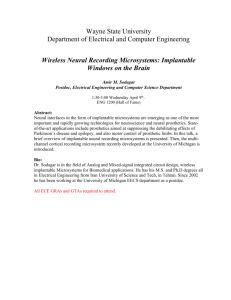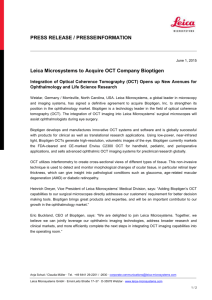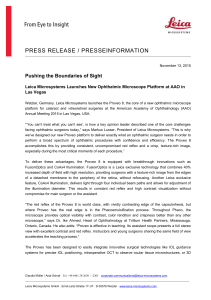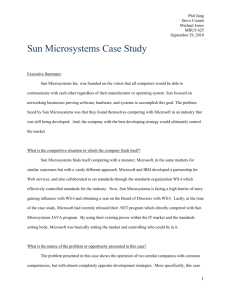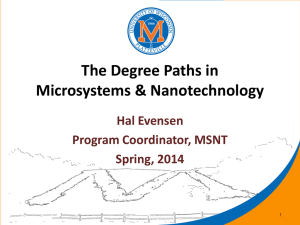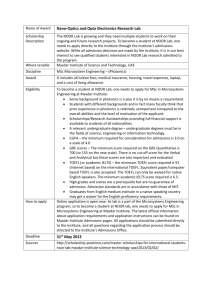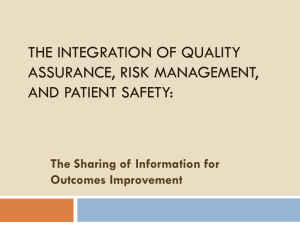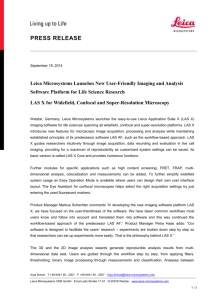Sun Microsystems: No longer shining
advertisement
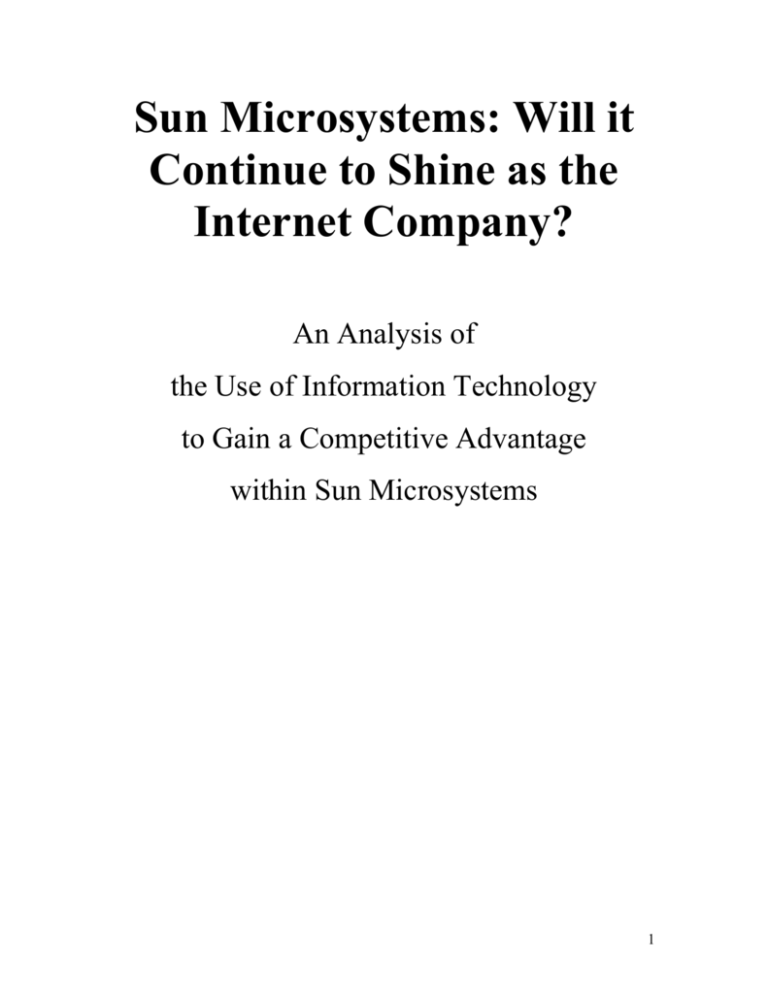
Sun Microsystems: Will it Continue to Shine as the Internet Company? An Analysis of the Use of Information Technology to Gain a Competitive Advantage within Sun Microsystems 1 Table of Contents Paper Objective Scope Section I: The Internet Hardware and Software Industry A. Industry Profile B. Competitive Strategies within the Industry C. Porter Model Evaluation of Industry Forces D. Globalization of the Industry E. Importance of Information Technology to the Industry Section II: Company Perspective: An Analysis of Sun Microsystems A. SUN Microsystems company Profile B. Market and Financial Performance C. The Competitive Strategy D. Significance of Information Systems E. Strengths and Weaknesses of Sun Microsystems Section III: Information Systems at Sun Microsystems. A. Structured Analysis B. Strategic Option Generator C. Roles, Roles and Relationships D. Redefine/Define 2 E. Significance of Telecommunications F. Success Factor Profile Section IV: A Final Analysis of the Success of Sun Microsystems A. The Success of Business Strategy and IT Used to Date B. The Effective Position of the Company for Future Performance 3 Objective The objective of this paper is to analyze key business strategies and the use of information technology by Sun Microsystems to gain a competitive advantage in the internet hardware and software industry. Sun Microsystems is one of the major players within this broad and brutally competitive technology related market. This paper will place major emphasize on Sun Microsystems and its position within the Internet Hardware and Software industry. This analysis will be accomplished in four sections. Section I discusses the Internet hardware and software industry by defining the structure, the general strategies and trends, the impact of globalization and the importance of information technology within the industry. Section II focuses on Sun Microsystems, describing the company, its competitive strategy and financial performance and its position within the industry. Section III gives a structured analysis of the role and use of information systems within Sun Microsystems, including a narrative of the factors which have contributed to the success of Sun Microsystems. Section IV discusses the success of Sun Microsystems use of information technology in support its business strategies in the past, and whether these factors have effectively positioned the company for the challenges of future. Scope The Internet hardware and software industry is one of the most dynamic and challenging industry’s in the world. This industry alone has a major impact on businesses from a wide range of markets and varying size. Companies within this industry compete by fulfilling the demand for increasingly robust, effective and scaleable internet server systems and by providing the server application environment that will be used to propel internet business objectives. To survive in this industry companies need to be able to provide a range of quality server hardware products and they need to be able to provide an effective operating system platform that will suit the needs of small, medium and large businesses. This paper will focus on three companies, which are primary contenders within the internet hardware and software industry. These include Sun Microsystems, IBM, and HP/Compaq. These companies tend to compete within three distinct segments, which include, low-end (less expensive), mid-range and high-end internet hardware/software solutions. Historically, high-end products have produced the most revenue, but in a tough, cut-throat economy, competitors within this industry are doing all they can to leverage competitive advantage from all segments of their market. Although, internet application software within this industry includes both, windows based operating system software, and UNIX based platforms, analysis will focus on UNIX based solutions, which are provided by all three top competitors within this industry. As illustrated in this graph, during the second quarter of 2002, Sun Microsystems held 39% market share as provider of low, mid, and high-end server hardware/software solutions. Hewlett Packard held second place with 31% market share and IBM finished third at 20% market share. [18]. Competitors Sun Microsystems IBM HP/Compaq Internet Hardware and Software Industry Server Systems range Operating System Market Share Q2, 02 Small, mid-range, high-end Solaris-Unix 39% Small, mid-range, high-end OS-2 31% Small, mid-range, high-end HP-UX-Unix 20% 4 SECTION I: THE INTERNET HARDWARE AND SOFTWARE INDUSTRY A. Industry Profile The internet hardware and software industry is dominated by companies who continually fight to increase their share of the market. Generally, these companies are characterized by being able to provide internet hardware/software solutions within the low, mid, and high-end server markets, including providing the Operating System application to drive the hardware. For examples, Sun Microsystems is continually trying to attract customers who have historically only implemented IBM or HP server solutions. These companies also fight to become the standard internet application solution. Growth within this industry is due primarily to the number of new products, reliability and scalability. Companies are also increasing alliances as they contend for international leadership and market dominance. Customers are looking for internet hardware and software solutions that will allow for tremendous online, internet, intranet scalability and flexibility, while at the same time providing on-time product delivery and exceptional customer service. The following chart shows the relative size of the dominant players within this industry for the past two years. The change in market share among the three segments shows the dynamic nature of this industry. The Internet server market generated 60 Billion dollars in sales during the year 2000. Low -end Server m arket share, 2000 Mid-Range Server Market Share, 2000 Sun Sun IBM IBM Compaq Compaq Compaq, 10% Compaq, 30% Sun, 37% IBM, 9% Sun, 44% High-end Server Market Share, 2000 Sun IBM, 11% Over-all Unix Server Market, Q3,2001 IBM Sun IBM, 10% IBM, 20.90% Sun, 56% HP IBM Sun, 28.80% HP, 28.50% During 2000, Sun Microsystems shipped more UNIX servers than IBM, HP and Compaq combined to lead the market in both shipments and revenue. Sun ended the year with a 44 per cent share in shipments and 35 per cent share in revenue. [19] 5 Entry-level UNIX server category: Sun posted 80 per cent growth year-over-year to take first place in shipments with 315,180 (44 per cent share). In units, Compaq, HP and IBM all suffered share point losses. In revenue, In contrast, IBM fell 28 per cent year-over-year and dropped five share points to end the year with nine per cent market share, while Compaq declined seven per cent to lose two share points for 10 per cent of the market. Mid-range Unix server category: Sun garnered the top spot for shipments in the midrange UNIX market with 37 per cent market share, while HP had 30 per cent and IBM 11 per cent. High-end UNIX segment: Sun took first place in worldwide revenue with 47 per cent share (US$2,107 million) and first place in worldwide UNIX shipments with 56 per cent share (1926 units). In revenue, IBM came in with US$842 million and 19 per cent share. In units, they shipped 342 systems for 10 per cent of the market. [4] Dominance within these segments is a very fragile proposition. Each of these companies is continually striving to attract various segments and to lure away customers from the competition. By the end of the third quarter 2001, Sun was No. 1 in the overall UNIX server market with 28.8 percent market share. HP was No. 2 with 28.5 percent, followed by IBM with 20.9 percent. However, HP had edged out Sun to take the top position in both the midrange UNIX server market for systems costing $100,000 to $1 million and the high-end UNIX server market for machines costing $1 million or more. [6] UNIX servers, used for tasks such as tracking inventory or performing stock trades, are the mainstay of the server market. More powerful than Windows servers and less costly than mainframes, Unix servers accounted for $29 billion of the $60 billion in total server sales in 2000. In order to remain financially sound each of these companies will have to continually innovate and provide a product that is scalable and enduring. Not only does the product quality have to be present, it has to be delivered without delay to customers. Factors, such as product support and customer service have to remain a top priority. B. Competitive Strategies within an industry Figure 4 presents the strategy components that must be addressed to compete within the internet hardware and software industry. Decisions regarding the most profitable server sector, whether a company should place a stronger emphasize on the high-end server sector, the mid-server or low-end server sector. The extent of support, customer service and product adaptability and reliability are key to defining the method of competition for any particular company. The markets and company structure are generally related to the size of the company, name recognition and its ability to produce cutting-edge technology at an affordable, effective manner. The ability to effectively outsource key components of your business has also become a key strategic element of business survival. Information systems play a key role and in the success of companies within this industry. Competitors need to be able to rapidly and effectively be able to respond to customer demands and provide solutions that customers are demanding, supporting strategies of growth, alliance and innovation. [1] 6 Internet Hardware and Software strategy Options Product Options Low-end Servers Solutions Mid-Range Server solutions High-End Server Solutions Customers Small Businesses Mid-Size businesses Large corporate entities. Markets Europe North America Asian Latin America Software Options Solaris HP-UX OS/2 Company Structure Alliances Independent Information Systems Major Role Minor Role Service Customer self service Customer full service Technical Support Figure 4 Differentiation Strategy The internet hardware and software industry follows a differentiation strategy to gain a competitive edge. Each company competes within the market by attempting to offer a more reliable, scaleable and effective hardware and software package. The main objective for a company, such as Sun, is to convince new customers, preferably customer’s from it’s rival companies, that it can offer a product that is better, faster, more stable and can do more things than what IBM or HP systems can offer. The dominant approach is to engineer systems that effectively increase efficiency and reduce over –head cost. Potential customers are looking for a provider who is a recognized leader within the industry and has the leverage to provide an effective product with quality customer service and product support to back it up. Innovation is key to attracting and retaining customers within this industry. [2] 7 Growth National and international alliances are a key component of strategy within the internet hardware and software industry. The top three competitors are also continually seeking to predict where demand will take focus. Purchase of new technology and differentiation of products has been a key to growth within this industry. Changing and expanding what product a company is able to offer to its customers is an ever evolving strategy focus and leveraged as tools for growth within this industry. Sun Microsystems is widely recognized for its Java, internet application development product and is continually striving to push it as the product of choice for platform independent software development application. Sun is also expanding into different markets by providing storage products and business software solutions. All with the focus of having Sun Server products as the back-bone for these extended products. Again, the key to growth is being able to have a clear vision, defined strategies, flexibility and innovative approach to all factors within your business enterprise. [6] Alliances All companies within this industry are involved in the acquisition of products and services from outside companies to help conduct business more effectively. Strategic alliances have helped companies like Sun Microsystems; expand from a hardware company into an Internet company. This has occurred through various acquisitions and e-business software alliances with companies like AOL and InfraSearch. InfraSearch is currently developing a fully-distributed P2P search engine which Sun said has the ability to return richer and more timely content on the Internet. Sun is banking that the addition of InfraSearch's technology in P2P computing will address the network fundamentals of searching, sharing and storing information, which Sun believes is the key to harnessing the power of the Internet. [17] Innovation Innovation with this industry involves searching for and applying methods that increase benefit to customers in a top to bottom approach. Companies like Sun are now focusing on selling more than just servers. Sun is assembling soup-to-nuts offerings that include storage, software, and related technology to help service providers expand their offerings, whether it's shuttling wireless e-mail to consumers or providing powerful back-office applications to corporations via the Web. "We're trying to find as many useful ways as possible to connect everyone, everywhere to the Net," says McNealy. It is the approach of providing a solution that meets the customer’s need from all angles and fulfilling that need with an efficient innovative idea is what gives businesses in this industry the competitive edge to survive in this weak economy. [13] C. Porter Model Evaluation of Industry Forces The Porter Model in Figure 5 defines the five forces that influence the competitive environment within the internet hardware and software industry. The intraindustry rivalry lists those companies that directly compete within the industry. It shows that Sun, IBM and HP/Compaq are the key rivals in the United States as well as globally. The model identifies the suppliers and customers that influence the competitive nature of the industry rivals. It also shows potential threats to the industry by identifying possible new entrants into the market and substitute products and services. [1] 8 IntraIndustry Rivalry As stated above, rivals within the internet hardware and software industry compete using a differentiation strategy. Those companies that continually reduce the overhead cost associated with operations will maintain leadership within the industry. Within the internet hardware and software industry a key point of rivalry is the struggle to achieve and maintain market dominance within all segments of the industry. This is achieved through constant introduction of products and features that make it attractive to customers. Figure 5 The Bargaining Power of Suppliers With the prolonged sag in the economy, suppliers are having difficulty remaining profitable. This has created declined bargaining power and increased efforts to reduce cost and increase sales. Many suppliers have had to enter into vendor partnership agreements with industry leaders or risk losing their customers. These partnership agreements involve automation of the vendor-customer relationship. Ordering, shipping, inventory control, and marketing information is shared using one database. This wealth of information is 9 valuable to the supplier by giving them timely information about their products. However, this benefit comes with the loss of power. This leverage has forced suppliers to focus their efforts on overhead cost reduction to stay competitive, or risk losing their market share to a competitor at a moment's notice. [14] The Bargaining Power of Customers Consumers within this industry demand high quality, expert service and a product that is sophisticated and offers unique tools to help them grow. Purchasing an internet hardware/software solution is not usually a small investment for customers within this industry, because of this they tend to be unwavering on demands. Product differentiation is increasingly harder to maintain and therefore companies within this industry need to remain focused on increasing market exposure, this means focusing on global customers, as well as establishing an identity as the most customer responsive, product savvy, business entity. Recently HP lost customers to Sun Microsystems, as it proceeded with its merger with Compaq. Customers perceived an unstable business environment within HP and opted for the rivals. This demonstrates how quickly companies can lose key customers within this industry. Those companies that meet the needs of consumers on all issues are successful. The companies that have failed to meet those needs risk loss of market share and reduced customer loyalty.[16] New Entrants New entrants are either new competitors entering a geographic market or an existing company making a major shift in its business strategies so that it becomes a direct competitor to the strategic business unit. As demonstrated above, using the Porter Business Model, the threat of new entrants primarily comes from the United States market. Sun leads the market for expensive, highly profitable servers for running ecommerce sites and business-to-business transaction services. That's a market that Intel wants to enter with its Itanium processor. Dell, with its efficient business model, has also been looking for ways to shift its market focus and gain recognition as a competitive provider of internet hardware and software solutions. Foreign companies have not been a big factor but potential is there, specially as Sun, HP and IBM continue to enter new global markets. [18] Threat of Substitute Products and Services A substitute is an alternative to doing business with the strategic business unit. Alternatives in this industry include business products like the UNIX based FreeBSD server operating system as well as influences from Linux and other open source, free distributions of UNIX based operating system applications. Another threat comes from a rising interest in what is being termed an ‘open net’ solution. Companies like Microsoft are teaming up with telecommunication companies and establishing grid network. These are networks that companies can connect to and run corporate level, high-intensity applications, rather than purchase the physical hardware and software solutions, the processing power is outsourced through these proposed network grid infrastructure. While Solaris is widely regarded as a solid software offering, the proprietary operating system comes at a cost, with licensing fees per system often running $500 or more. By contrast, Linux is available for free from various vendors on the Internet. If customers increasingly choose Linux as their preferred platform, Sun could potentially lose millions of dollars in revenue. [5] Conclusions Based on the Porter Competitive Model Analysis The Porter Model analysis leads to the following conclusions. First and foremost, intra-industry rivalry is intense. Despite Sun’s strong position in the industry, it faces continual challenges both nationally and internationally as rivals intensely race to provide better, more robust products. The threat of new entrants is very real and alliances are increasingly important in this truly, global industry. Buyer strength is at an advantage. Competition between rival companies is so intense that they are forced to comply with buyer 10 demands or lose market share quite quickly. The internet hardware and software industry is a 60 billion dollar business, this type of revenue and size of business cannot not easily be ignored by suppliers. Suppliers are equally keenly aware of their need to encourage and facilitate friendly alliances with corporations within this industry. D. Globalization of the Industry All three companies in this industry are top global competitors and are increasingly focusing on international recognition and forming allies and alliances with companies in various parts of the world. Due to the current economic conditions, the three companies are desperately seeking ways to innovate and predict the technology trends. Most small companies are being replaced or seeking alliances to strengthen financial postures. All companies have experienced lay offs and have cut down on expenses, seeking ways to stream line their operations. The national companies have recognized the saturation trend, as well as the increased competition that it represents. As a result, Sun Microsystems, IBM and HP are focusing on international efforts. They are increasing alliances and forging strong relationships with foreign businesses, primarily across European and Asian markets. During calendar year 2000, Sun Microsystems, surpassed IBM in total server revenue in the United Kingdom and grew faster than any other major server company in Western Europe, according to Gartner Dataquest. [3] Sun also grew faster than its competitors in Germany, Sweden, France, Italy, and Switzerland. In 2000, Sun grew 35, 46, 37, 58, and 60 percent respectively year-over-year. When looking at all of Western Europe, Sun grew 44 percent over that same period. Foreign sales account for approximately 49% of Sun’s revenues.[18] E. Importance of Information Technology to the Industry Information technology has and always will provide a vital role with the internet hardware and software industry. Companies within this industry are strongly committed to fully leveraging the power of IT technology to gain competitive advantage. Sun Microsystems, for example, functions under the strategy of “running Sun with Sun, they use these servers not only to “test their own products” but to show they are committed to products they produce. Vendors have become partners with corporations through the automation of the key processes of buying, inventory distribution and inventory management. Information technology has provided the foundation to build interdependent relationships throughout the supply chain. The sharing of information, streamlining of order fulfillment processes, such as ordering, order fulfillment, shipping, payment, and scheduling has decreased the cost of doing business for both vendor and reseller. 11 Internet Hardware and Software Industry Value Chain Research and Developmen t Engineering Production and Manufacturing Marketing Sales & Distribution Product Support Customer Administrative and other value added Figure 6 SECTION II: COMPANY PERSPECTIVE: AN ANALYSIS OF SUN MICROSYSTEMS. A. A Sun Microsystems Profile Background Sun Microsystems was founded in 1982 by Andreas Bechtolsheim, an electrical engineering PhD student in the Computer Systems Laboratory (CSL), Scott McNealy and Vinod Khosla, roommates at Stanford's Graduate School of Business, and Bill Joy, a PhD student in computer science at the University of Califomia, Berkeley. Sun’s first product was a workstation built by Bechtolsheim, which he constructed using spare parts from the Department of computer Science, Standford University, and Silicon Valley supply houses. Sun is an acronym for Stanford University Network. [8] Sun Microsystems is headquartered in Mountain view, California. Scott McNealy is the current CEO and has been since 1984. Scott McNealy graduated from Harvard with a BA in Economics. He followed that with an MBA from Stanford. McNealy has steered Sun to constant growth and innovation. His vision and business sense have made him one of the most influential and widely quoted leaders in the complex, and fast-moving IT industry. "60 Minutes" called him "one of the most influential businessmen in America." Throughout his career, McNealy has been driven by the focus of maintaining and growing Sun's reputation as a constant innovator and strong competitor. McNealy's ideas about computing often predate industry trends. For more than ten years, he has been advancing Sun's slogan, The Network Is The Computer -- a succinct statement of the company's vision of seamless connectivity. According to a recent story in Business Week, "Sun's star has never been higher, and McNealy's vision of computing never closer to happening." [17] The Company With offices in 170 countries, and over 39,000 employees worldwide, Sun is a $18.25 billion global leader in internet software and hardware solutions. Sun’s products are based on several core technologies, including: Solaris operating environment, the UltraSPARC (scaleable processor architecture) 12 Microprocessor architecture and theJava programming language. In August of 2002, Sun extended its product line to include, its new first entry level server, the Sun LX-50 capable of running both the Solaris Operating Environment and the Linux operating system. The following are the core elements of Sun’s business strategy An end-to-end architecture that extends the Java technology based programming environment from devices as small as smart cards and cell phones to large multi-million dollar servers. On-going innovation in microprocessor architecture, systems design, and software to help ensure continuing technology leadership and resulting price-performance advantage. Commitment to open public application programming interfaces. Sun believes customers are best served when they have a choice and a competitive vendor environment. This requires that the industry agree on programming standards and compete to create the highest quality implementation. Sun’s partner community enables them to deliver an increasing level of integration between systems, storage, software and services to make solutions faster to deploy and to help ensure the best possible performance. A direct sales organization for large customer accounts increasingly organized to deliver a single point of contact with Sun. A mission-critical support organization staffed worldwide to help ensure high satisfaction and profitable use of our products. [8] Company Culture Sun Microsystems is committed to purposefully providing a diverse business culture. Sun’s vision of corporate culture involves, “an empowered workforce where the unique skills and talents of all employees are appreciated and maximized to increase Sun's success in the global marketplace” [8]. To this end, Sun provides a variety of services that enable an efficient, diverse company culture. Some of these services include: Issue Resolution and Appeals Process Affirmative Action plans and EEO/AA compliance monitoring activities Diversity consulting and training Sponsorship of Sun's affinity groups and events B. Market and Financial Performance Markets: Telecommunications, financial services, government, manufacturing, education, retail, life sciences, media and entertainment, and health care. Revenues: $12.5 billion in fiscal 2002. Products and Services: Network servers, data storage systems, engineering workstations, desktop appliances, microelectronics, software systems, service-delivery applications, cross-platform technologies, consulting and support services. Ranking: Sun is ranked 112 on the Fortune 500 index.[8] 13 KEY FINANCIAL DATA Net Revenues (dollars in millions) Revenue: $12.5 billion in fiscal 2002 Year 2002 Change 2001 Change 2000 Computer Systems and Network Storage Products $8,574 (39.6)% $14,196 10.6% $12,841 Other products $519 (36.6)% $819 $580 Products net revenue $9,093 (39.4)% $15,015 11.9% Percentage of total net revenues $72.8% (9.5)pts 82.3% (3.1)pts 85.4% Services net revenue $3,403 5.2% $3,235 40.7% $2,300 Percentage of total net revenues 27.2% 9.5pts 17.7% 3.1pts 14.6% Total net revenues $12,496 (31.5)% $18,250 16.1% 41.2% $13,421 $15,721 The following table sets forth for the Ñscal periods indicated the high and low sale prices for our common stock as reported by The Nasdaq National Market: Year Fiscal 2002 High Fiscal 2002 Low Fiscal 2001 High Fiscal 2001 Low First Quarter $18.24 $7.52 $64.66 $41.13 Second Quarter $14.72 $7.81 $61.00 $25.13 Third Quarter $7.88 $35.13 $14.10 4.55 $23.57 $12.85 $14.41 Fourth Quarter $9.55 C. The Competitive Strategy Vision: Ensure that network services are available to anyone, anywhere, anytime, using any device. Business Philosophy: Open standards and open programming interfaces increase the value of Net-based solutions and create a larger market for all players. Value Proposition: We make the Net work for you. The basic driving strategy for Sun Microsystems is to be the most effective innovators within the internet hardware and software industry. This strategy has been powered by Sun’s vision of having a networked world of computers that talk to each other no matter who built them, and being the company that provides and tools and infrastructure to make this happen. [8] D. Significance of Information Systems From day one, all Sun systems included a network interface and all employees were using electronic mail. That was 1982. Since then, Sun has established a history of innovation and leadership that stretches from the protocols that propel the Internet to the widely adopted Java(TM) technology--used in everything from smart cards to supercomputers[8]. Sun provides breakthroughs that change the way people work and the way companies do business. 14 E. Strengths and Weaknesses of Sun Microsystems. Strengths Power over Suppliers Due to the size of Sun Microsystems and revenue produced within this industry, Sun Microsystems has a competitive leverage on its suppliers. Product recognition and market share have a lot to do with the attractiveness to suppliers within this industry. Sun Microsystem’s strategy regarding suppliers is to only work with suppliers who are able to leverage technology. Suppliers for Sun Microsystems consist of those who can supply the following products and business elements. [8] Operations: For suppliers marketing products or services that support business operations, including maintenance, repair and operations ("MRO") Production: For suppliers marketing products or services to support the manufacture or production of Sun's products. Customer Services: For suppliers marketing professional, technical, repair or maintenance services to support Sun's customers. Other Opportunities: For suppliers marketing human resource services, or for those seeking information on how to become a Sun value added reseller or developer. Distribution System Sun Microsystems has a well established, effective global distribution system. Sun Microsystems has established a physical presence in over 170 different countries. Technology to facilitate the distribution of Sun products and business objectives is deeply embedded into the distribution process. Efficient distribution methods have been key to propelling Sun Microsystems as a global leader of internet hardware and software solutions. Weaknesses Company Size Sun’s size and leadership position make it the prime target for established competitors and those seeking to enter the industry. The goal for Sun Microsystems will be the ability to remain flexible and respond quickly to market demands despite the size of its organization. Competition At the heart of Sun's product introduction is its plan to fight off aggressive competitors like HewlettPackard Co., IBM Corp. and even Intel Corp. from regaining a foothold in the high-end server market. Sun still plans to fortify its product offerings on the high end with a successor to the E10000; however, competitors also plan to follow suit[16] 15 Company Image Making progress toward Sun’s ‘grand ambitions’ won't be easy in this economic slowdown. Sales in the most recent quarter grew just 2%, and Sun will be tested to avoid the layoffs that have plagued others within its industry. The sagging economy and pinched financial conditions create obstacles in Sun’s struggle to provide the best customer support and quality products. International Challenges Global positioning, alliances and foreign potential rivals along with foreign economic policies will continue to be a challenge for Sun and its competitors. In a saturated local market, only those who can effectively acquire and maintain overseas dominance, is ensured continual survival within this demanding industry. III: STRUCTURED ANALYSIS OF INFORMATION SYSTEMS USE This section provides an analysis of the use of information systems by Sun Microsystems to gain a competitive advantage. It focuses on business strategies that influenced the requirements or the improvements that were made possible through the use of information technology. a. Strategic Option Generator The Strategic Option Generator can be used as both a planning vehicle and to do an after the fact evaluation of the impact of information systems on major business strategies. In this case it is used as a conceptual model to identify the business opportunities pursued by Sun Microsystems and to identify strategic options that they selected relative to the use of information systems. The different options selected by Sun Microsystems pertaining to targets, thrusts (strategies), modes and direction are summarized using the Strategic Option Generator in Figure 4. [1] Figure 4: Strategic Option Generator Target Customer Thrust Innovation Mode Supplier Differentiation Cost Offensive Competitor Growth Alliance Defensive Direction Use Provide Executive Target: Sun’s strategy is strongly focused on beating competitors to product introduction and global presence. Although is done by means of introducing highly competitive and efficient/functional products, the primary driving force has been to outdo the competition, this makes the competitor the main target. Thrust: Sun Microsystems uses differentiation as its main thrust. This differentiation is based on not only offering a better product, but also providing quality service, responsiveness, and flexibility with customers. Sun’s goal to “ensure that network services are available to anyone, anywhere, anytime, using any device” is propelling innovation within Sun Microsystem’s and enabling it provide a unique, desirable product. For example, Sun Microsystem’s server’s continue to be the industry benchmark for intense processing, reliable server platform, specifically where heavy computational processing is involved, which tends to be in research environments within Colleges and corporate Research and Development sectors. Sun Microsystems works with the objective of improving performance while attempting to some extent, lower the cost of the product. 16 Mode: Sun Microsystems had long been operating in offensive mode, in 2000 Sun held 56% market share in the high-end internet hardware/software segment, and continually rated as the top choice for high-end, sophisticated internet solution. In the third quarter 2001, IBM had closed the gap. In Q3, 2001, IBM ended with 28.5% and SUN with 28.8% in the over-all Unix server market. Based on this trend and the current economic conditions, Sun Microsystems now finds itself operating more in a defensive posture. HewlettPackard/Compaq. and IBM are each planning to roll out aggressive product and marketing programs designed to lure Solaris customers from Sun to their respective Linux offerings. [20] Direction: Sun Microsystems uses its IT tools in both "USE" and "PROVIDE" modes. Sun Microsystems commitment to ‘run Sun with Sun’ is a reflection of Sun’s commitment to ensure reliable useable products. By encouraging Sun employees, both administrative and technical staff, to operate Sun products, Sun helps ensure product quality and performance. In essence, this tactic allows Sun “to eat its own dog food” and thereby allowing it to more quickly recognize product weaknesses and create innovative solutions that allow Sun products to stand out. The PROVIDE aspect here, relates to the internet hardware and software products that Sun provides to its customers. These, as mentioned earlier, include server hardware and operating system platform to run information systems within the customer organizations. Sun’s goal is to provide a ‘one stop shopping’ solution for businesses requiring proven internet hardware and software solutions. Customers use Sun products and services to build mission-critical computing systems on which they operate all elements of their businesses. [10] Roles, Roles and Relationships Sun Microsystems has always placed major importance on the role of information systems in order to compete successfully and leverage dominance within the industry. Sun Microsystems operates with information technology processes built as an integral part to day-to-day business objectives Roles of Senior Management Chief Executive Officer, Scott McNealy, has a Bachelor’s degree in Economics and an MBA degree from Stanford University. He has no formal Engineering or Computer Science background but has a keen understanding of the strong role of information systems, and how it can be leveraged to achieve a more successful, competitive business posture. A strong representation of this understanding is embodied in the strategy of running Sun Microsystem’s with Sun Products; the “Sun on Sun” philosophy has also allowed Sun to use its own corporate environment as a test bed for developing and showcasing new enterprise computing models. This strategy has also served to foster a corporate environment where internal IS functions are looked at as key factors in propelling the success of Sun Microsystems [9] A key Sun executive, charged with functioning as the leader of the “Sun on Sun” project is Chief Information officer H. William Howard. He also provides leadership and management to corporate executives and Sun employees on technology deployments throughout the world. Mr. Howard is very technology oriented, along with extensive IT experience he holds University degrees in Science and Engineering, as well as Business Administration. He’s background in Technology, as well as Business, allows Mr. Howard to function effectively in organization that is very intentional at using technology to achieve clear business objectives. [13] Roles of Users of Information System From day one, in 1982, all Sun systems included a network interface and all employees were using electronic mail. More recently, Sun Microsystems has been requiring its employees running Microsoft Windows and Office on their machines and is strongly encouraging them to replace the software with Sunsupported products such as Solaris, Linux and StarOffice. The Sun corporate architecture is already structured using only Sun hardware and software products. This is in following the established “Sun on Sun” business philosophy and emphasizes the key role of users with information systems. 17 Redefine/Define This concept emphasizes the methods used by a company to distinguish itself from its primary competitors. Specifically, the approaches that Sun Microsystems has used to redefine itself as a company and thereby provide greater value to customers within its industry. The three approaches used to define/redefine a business include: Business Processes: This has to do with the internal processes of the business. For example, L.L Bean started business by providing mail order service for its customers. As their business and industry evolved they found it necessary to restructure business processes to accommodate customer orders via phone. This provided value to customer since they were now able to talk and order from ‘live’ person rather than exclusively through the mail [1]. Products and/or Services: This has to do with changing products or services in a manner that brings more value to customer and thereby providing a competitive advantage to the business. A good example of this can usually be found in a bank that expands from offering basic banking options, such as savings/checking accounts, loan services, to one that is able to offer a full line of investment and retirement options. The Business: This is generally the most difficult approach in terms of a company redefining itself within an industry. This approach involves the most dramatic change to a business entity. A good example of this approach would be Charles Schwab. Charles Schwab redefined its business by changing from an approach that emphasized the value of discount brokerage firms as a means of building a large customer base. to an approach that emphasizes customer care and quality service. Sun Microsystems is committed to evolve into a business that is able to serve as a “one-stop-shop” for its customers. They are achieving this by adding products and services that are able to fulfill a more expansive list of needs from customers within the internet hardware and software arena. Sun Microsystems is redefining the industry by changing its business approach and consequently delivering a more targeted array of products and services. For example, Sun believes that solid business relationships are built on trust. And the best way to earn that trust is “by delivering quality in everything the company does - building quality products and services, and forging quality relationships with employees and customers, allies and shareholders - through honest, ethical behavior”. Based on this business philosophy, Sun is continually challenging itself to provide quality, flexible customer service and support. As part of the ‘one-stop-shop’ philosophy Sun is providing a wider range internet business products, including: Network servers, data storage systems, engineering workstations, desktop appliances, microelectronics, software systems, servicedelivery applications, cross-platform technologies, consulting and support services. Sun is also putting extra emphasizes on the ‘open source’ development. Getting involved with Linux, providing an entry level Linux platform.[8] Sun has also revolutionized the computer industry by making its interfaces freely available, believing that the company, its allies, and its customers benefit most when the whole industry is healthy, thriving and competitive. Sun was built around this concept of open systems, and the business model, company structure, and information technology that tie it together all reflect this concept. 18 Figure 6: Sun Microsystems Value to Customer Chart Significance of Telecommunications The role of Telecommunications, describes how employees, customers, suppliers interact and are able to accomplish business objectives. More generally stated: “The mission of Telecommunications is to provide effective and efficient movement of all forms of information between various combinations of people and business equipment.”[1] Sun Microsystems’s ‘Sun-on-Sun’ philosophy gives a glimpse into the role and significance that Sun Microsystems’s places on Telecommunication as a means of establishing and retaining a competitive advantage. Effective network/telecommunications infrastructure is integrated into business philosophy and crucial to the success of Sun’s business objective. Sun’s vision and strategy goals are propelled by a successful corporate network infrastructure, which is used to provide the customer service, client communications, and vendor interactions which are critical to the success of Sun Microsystems. Success Factor Profile The four major success factors that go a long way in explaining Sun’s success in this entire endeavor are: Vision: Sun was founded with the “…vision of computers that talk to each other no matter who built them. A vision in which technology works for you, not the other way around.” This vision has been the driving force behind the structure and direction of Sun Microsystems. The ‘one-stop-shop’ concept is a reflection of this vision and has been the propelling force behind the alliances that Sun has made with suppliers and 19 the relationships it has cultivated with a large community of commercial software developers, system integrators, and resellers to add value to Sun products and services and to extend its reach and expertise. This partner community has enabled Sun to deliver an increasing level of integration of Sun systems, storage software and services. In order to sustain the long-term viability of the business, Sun Microsystems will continue to nurture its relationship with customer, suppliers and allies in order to retain its current leadership role with the Internet Hardware and Software industry. Information Systems Integral to the Business: Without Information Systems Sun would effectively not be able to conduct business at the level that it does today. Sun would not be able to maintain communications with global suppliers and would not be able to provide the customer service or support that is enabling Sun to remain a global leader. With the use of information systems, Sun and rivals within this industry would not be able to compete effectively and would eventually fail to exist as a business entity. Information systems are critical to surviving with this industry. Culture: Culture is compromised of employees that are keenly aware of the competitive forces and factors that drive the success of Sun. A main factor for Sun is customer service. This is encouraged and enforced in the Sun environment and is key to the market share of Sun products, on a global scale. Sun Microsystems is very purposeful in maintaining a diverse work environment and placing an emphasize on the worth of its employees and how critical they are to a successful business process. Michael Morris, the openly gay Vice President, General Counsel and Secretary of Sun, notes that “it is part of Sun's basic corporate philosophy that employees be judged only by their performance in their job and their ability to work with others. He says that it is "practically ingrained in our DNA" at senior management levels to affirm the diversity of its workforce:” Even the recent political assault on Affirmative Action in California has had no effect on the determination to promote diversity at Sun. [12] Plan Implementation: The Sun business model emphasizes partnerships with local companies of the highest caliber as these best understand the requirements and business culture of the local territories. Sun Microsystems is effectively postured to quickly implement changing business objectives, both on a national and international scale. The key component to achieving this has been Sun’s focus on delivering high value, low cost platforms, and its network of local business partners - distribution resellers, value-added resellers, system integrators, and independent software vendors (ISVs) As a result of the closer relationship between Sun and its ISV partners, for example, there are literally tensof-thousands of commercial and technical solutions available for Sun's open SPARC/Solaris and Java platform that cover diverse industries. In Asia, these ISVs include Oracle, Sybase, Lotus, Cadence, Baan, SAP, Peoplesoft, Computer Associates, Mentor Graphics, SAS and many more. [16]. Pervasive Computing Literacy: Employees of Sun Microsystems are some of the most computer literate members within this industry. Specifically, with Sun products. This is due primarily to the use of internal Sun products, ‘Sun on Sun’ focus, and because it develops hardware and software internet components that are also used within the corporate infrastructure. The literacy of Sun employees is an additional competitive advantage to Sun Microsystems as a business entity. 20 SECTION IV. A FINAL ANALYSIS: THE SUCCESS OF SUN MICROSYSTEMS A. The Success of Business Strategy and IT Use to Date Sun has a record of continual innovation and leadership, extended with the adoption of its Java technology, a breakthrough computing architecture that has captured the imagination of software developers worldwide and has become a de-facto industry standard architecture for the Internet and corporate intranets. Information Systems has definitely been a primary key to the leadership status that Sun Microsystems currently enjoys. The “sun-on Sun’ objective, including the stance that ‘The network is the computer” has directed Sun to the production of Products and Services that have challenged the tip of technology and what customers are seeking to accomplish as they require more robust, adaptable hardware and software internet infrastructures. The role of senior management has been critical and absolutely essential to the direction Sun has taken in order to respond to industry demands. Global presence has allowed Sun Microsystems to continue to lead the industry by dominated new market segments and acquiring a global supplier relationship and establishing efficient distribution channels and thereby expanding the possibilities for continual growth in various other global regions. The success that Sun is currently enjoying would not exist without the Information System structure that is embedded into every dominant business process with Sun. [16] Company Culture has enabled Sun to cultivate a community of employees and development communities that is eager to develop a quality product and most importantly is able to bring a sense of pride to Sun development platforms. This sense of “pride in workmanship” mentally is what is driving Sun Developers to produce well thought-out products that respond directly to what customers are asking for. Components that have been critical to the success of Sun Microsystems, with respect to company culture and developer communities include: A robust partner community. Cultivating a large community of commercial software developers, system integrators, and resellers to add value to Sun products and services and to extend Sun’s reach and expertise. The partner community enables Sun to deliver an increasing level of integration of systems, storage, software and services to make solutions faster to deploy and to help ensure the best possible performance. B. Effectively Positioning the Company for the Future With offices in 170 countries, and over 39,000 employees worldwide, Sun is an $18.25 billion global leader in internet software and hardware solutions. During the past few years, the role of information technology has become even more important to the success of the organization. Due to the saturation of the U.S market and some of the difficulties of expanding to international markets, innovative products, customer service approach and business processes has become even more pivotal to the components of growth and leadership within the internet hardware and software industry. The ability to predict market trends and deliver a quality, solid products with innovative features will continue to attract to right customers to Sun products and services. All competitors within this industry are keenly aware of the challenges of competing within this industry and continually strive to pull customer focus from rival businesses. For example, In August of 2002, Sun extended its product line to include, its new first entry level server, the Sun LX-50 capable of running both the Solaris Operating Environment and the Linux operating system. HP also announced its Software Porting Express Service, while IBM planned on rolling out its Solaris-to-Linux program. [19] Business process innovation, effective product and services, a dynamic company culture, along with business savvy employees with a clear understanding of the vision of Sun Microsystems will continue to keep Sun Microsystems a key player and company of choice within this industry. 21 Bibliography [1] Callon, Jack D., Competitive Advantage Through Information Technology (New York, NY: McGraw Hill, 1996). [2] Zander, Edward (2000) Q&A with Sun Microsystems' Edward Zander http://www.businessweek.com/ebiz/0005/0504zander.htm [3] BBC News (1999) Microsoft Deposes Competitors http://news.bbc.co.uk/1/hi/special_report/1998/04/98/microsoft/330933.stm [4] Liu, Bob (2001) Sun Microsystems Hits Midrange Market Segment http://www.internetnews.com/infra/article.php/720031 [5] Kanellos, Michael (2000) Intel CEO says Sun model doomed http://news.com.com/2100-1001-244768.html?legacy=cnet&tag=bplst [6] Ganier, Lisa (2001) Sun is worlds fastest growing server company, says IDC tally. http://www.sun.com/smi/Press/sunflash/2001-03/sunflash.20010314.3.html [7] Lyman, Jay (2002) HP Challenges IBM in declining server market, http://www.newsfactor.com/perl/story/19264.html [8] Sun Microsystems (2003), About Sun Microsystems, INC. http://sun.com. [9] Leaders of the Information Age, CIO Magazine,1997 http://www.cio.com/archive/091597_mcnealy_content.html [10] Sun Microsystems (2003) iForce Solutions. http://www.sun.com/executives/iforce/solutions/ [11] Sun Microsystesm, “Sun Microsystems, co-founder resigns, (1995) http://www.sun.com/smi/Press/sunflash/9508/sunflash.950810.3737.html [12]Tharsing, Chip (2002) Sun Microsystems http://www.planetout.com/pno/money/article.html?type=1&article=33 [13] Sun Microsystems, “Sun Microsystems Corporate Information” http://www.sunmicrosystems.com/aboutsun/investor/corporate_info/officers.html [14] Fox, Jenna (2003) Sun Microsystems, Purchasing Research Service http://www.purchasingresearchservice.com/js/rs/pid_8.site_1.cat_10591.id_738113.html) [15] Krill, Paul, (2002) Sun ponders offering open-source Solaris. http://www.infoworld.com/article/02/12/05/021205hnopensolaris_1.html [16] Galli,Peter (2002) Solaris in the Cross Hairs http://www.eweek.com/article2/0,3959,462121,00.asp [17] Business Week online, Scott McNeally, May 14, 2001 http://www.businessweek.com/magazine/content/01_20/b3732637.htm [18] Aun, Fred (2001) Solaris Integrators: Rock solid foundation. http://www.eweek.com/default/0,3960,,00.asp 22 [19] Shankland, Stephen (2000) IBM, Sun jockey for position in Unix server market www.CNETnews.com [20] Peterson, Scot (2002) McNealy comes out swinging, http://www.eweek.com/category2/0,3960,92,00.asp 23
